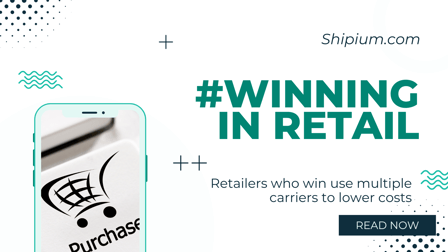Fast, Free & On-Time Delivery (For Less) Helps Retail Win

Customers don’t care about your single carrier relationship or superior rate negotiation skills, they want their items fast, free, and on-time. It’s your job as a modern operator to put their needs and desires first and use the best carrier for the job, not just the one you are locked into. I learned the value of this lesson in the early 2000’s when helping Amazon switch from solo dependency on UPS to utilizing a multi-carrier mix to drive shipping speed and cost improvements.
The power of flexibility is available to everyone today with the right approach. Start by ditching the single carrier relationship model you’ve been reliant on for years. You know, the one that disappoints every peak holiday season. It’s not getting better—in fact the performance of each of the three national carriers, FedEx, UPS and USPS has steadily declined due to structural issues including poor earnings (both FedEx and UPS stock is down 4% as of this article), wage pressures, supply chain issues and constrained labor.
Despite the threat of rampant inflation and a return to brick and mortar shopping cutting into online shopping, US consumer spending online is still on track to hit the $1 Trillion mark in 2022. In order to take advantage of record online shopping this holiday season, it’s critical that every retailer, no matter the size, break free of the single carrier point of failure and put the customer experience front and center.
Single Carrier? Single Point of Failure
What’s wrong with the single carrier model? To find out, we indexed the top 750 eCommerce retailers by annual online revenue based on the industry data provided by
EcommerceDB.com. For each website, we investigated their online shipping policies (examples here and here), and went through the buying process to view shipping options at checkout. Combined, we could cross-reference whether or not a given retailer used a single carrier.
We found 22%, or 165 retailers explicitly stated or demonstrated, they used a single carrier. An additional 17%, or 127 retailers, used two carriers, but the format was primarily relying on one of FedEx or UPS, then using The Postal Service for P.O. Boxes only, or something similar.
Combined, 39%, or 292 of the top 750 online retailers relied on a single carrier. That’s a lot of assumed risk during peak shopping seasons.
As a mitigation strategy, moving from a single to multiple carrier strategy is just good business as it helps you get out from under the thumb of carrier limits or poor performance. Most importantly, it provides the modern operation leader the ability to arbitrage services to drive the best rate. This is the best and fastest way to truly reduce costs while ensuring performance remains acceptable.
Carrier flexibility equals customer loyalty
Fixing this problem in time for peak requires both a business strategy and a technology solution working in partnership.
The business portion is logically simple: secure more contracts between you and multiple carriers specific to your shipping profile, either directly or through a third party logistics provider. In this manner, the rise of regional carriers are front and center.
The technical solution has historically been more complex, requiring multi-month on-site TMS integration and manual analysis of shipping methods from each carrier to best configure for fast or low-cost shipping options (but typically not both). It’s this combo of carrier rate contract negotiation, warehouse technology integration and shipping speed/cost analysis that is the historic reason why 39% of the top 750 retailers still rely on a single carrier solution, whether they want to be or not.
Enter Shipium. In 2019 we launched Shipium to help retail businesses put logistics management technology at the center of their growth strategy the same way I did leading Prime’s operations for almost 20 years. Our platform enables retailers to plug in carriers and optimize their last mile by quickly utilizing multiple methods to improve delivery speed and reduce shipping costs. The result is carrier flexibility that makes online shoppers happy, which is, afterall, the key to smart retail.

Diagonal thinker who enjoys hard problems of any variety. Currently employee #5 and the first business hire at Shipium, a Seattle startup founded by Amazon and Zulily vets to help ecommerce companies modernize their supply chains. Previously was CMO at Datica where I helped healthcare developers use the cloud. Prior to that I came up through product and engineering roles. In total, 18 years of experience leading marketing, product, sales, design, operations, and engineering initiatives within cloud-based technology companies.


